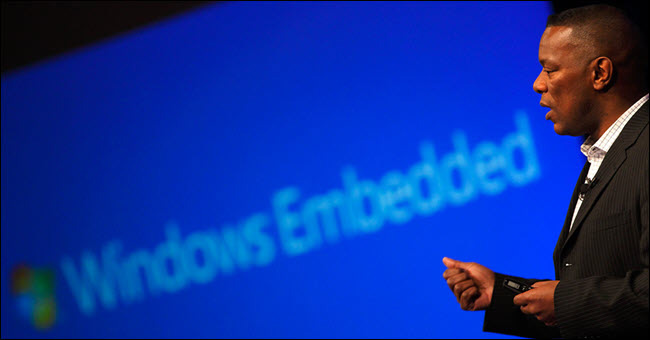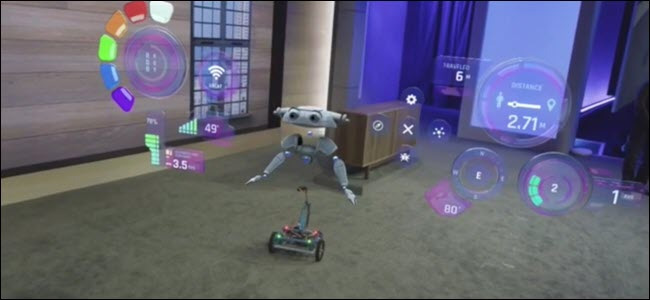What is Windows 10 IoT? And when do you use it?
Microsoft provides Windows 10 in nine separate versions, from Home, Enterprise to Server. Windows 10 IoT (Internet of Things) is the version that you rarely own but is the version you used more than you think.
- How to install Windows 10 IoT Core on Raspberry Pi 3
Windows 10 IoT evolved from Windows Embedded
Windows 10 IoT was developed from the previous Windows version of Windows Embedded. You may not know the previous ATMs running Windows XP. These ATMs and other similar devices run Windows Embedded (XPe). The goal is for the reduced version of the operating system to run well on weak hardware.

This operating system is used by banks for ATMs, retailers used for POS systems and manufacturers use it for simple sales. However, Windows IoT is not a brand-new version of Windows to take advantage of Internet of Things and not just for large businesses and corporations. This is evident in two different versions of this operating system: IoT Enterprise and IoT Core.
IoT Enterprise is for using multiple devices
Microsoft developed Windows 10 IoT in two directions, Enterprise and Core. The Enterprise version is basically Windows 10 Enterprise but has additional lock controls. For example, with these added controls, you can force Windows to display a single kiosk application. Windows will run it in the background but ordinary users cannot access these services. The automatic check-in kiosk machines you can often use Windows 10 IoT Enterprise.
Similar to Windows 10 Enterprise, you cannot purchase licenses for IoT Enterprise in the store. Microsoft distributes licenses through retail partners and OEM agreements. Since this is the full version of Windows, you will own all the power it has. However, this version has a disadvantage of not running on ARM processors.
IoT Core for simple boards, programs and sensors

On the other hand, with the IoT Core version, you won't get the full Windows Shell experience but instead the operating system can run a unified Windows application (UWP) and background process. In addition, IoT Core can run on ARM processors. You can choose IoT Core to run simple applications that don't require much direct interaction from users. For example, Glas Thermostat uses IoT Core. And thanks to ARM compatibility, IoT Core can run on a simple board like Raspberry Pi.
This feature makes IoT Core a great choice for prototype production or a one-person project. Hackster, a community of hardware and software developers, hosts a lot of IoT Core projects such as identified pet stables, face recognition doors, smarthome control panels, etc. These are all projects. You can build it yourself if you have the necessary skills. Microsoft even demonstrated a robot based on Raspberry Pi using Windows IoT and hologram interaction. Microsoft provides the resources you need to download IoT Core with a free license for personal use.
- 10 great projects combining Raspberry Pi and Windows 10 IoT Core
In addition, IoT Core on Raspberry Pi or Minnowboard can be paired with sensors and mechanisms such as cameras, PIR sensors, servo and temperature sensors for use with many different purposes. This allows Windows 10 to communicate with the data collected by these sensors. This is the basic premise of the Internet of Things.
Windows IoT is a closed source option for Visual Studio developers
You might wonder why people choose Windows IoT instead of popular operating systems like Linux or Android. The answer lies in the purpose of using the device, the target device object and the device creator.
You probably know the advantages of open source like licensing options, high customization capabilities but open source is not the best choice for every situation. Sometimes specific projects require closed source (or proprietary) software. Some businesses and governments prohibit the use of open source in purchases. Even if a company does not prohibit open source software, these software are not recommended.
Ignoring the advantages and disadvantages of closed and open source, Windows 10 IoT has advantages for certain users. This version links to Visual Studio and you can use this IDE to develop programs. In fact, IoT Core is designed to run headless programs (without a graphical interface) and connect to other Windows 10 machines for programming and feedback. If you use a lot of Visual Studio, you should choose Windows 10 IoT instead of other programs to save installation time and get acquainted.
- 9 extension Visual Studio Code for easier programming
Ordinary users may not download and use Windows 10 IoT, but that doesn't mean they won't catch it. If not a developer, this operating system works in ways you can't see. It can be in kiosk machines you use to order food at a restaurant or prepare your next cocktail. Even if you are a developer if you find learning to program on other operating systems like Linux too time consuming, consider Windows 10 IoT as an option for your next project.
You should read it
- Microsoft claims Windows 11 will save companies millions of dollars
- 10 great projects combining Raspberry Pi and Windows 10 IoT Core
- How to Install Windows 11 Enterprise in VirtualBox
- Official Windows 8 version for 90 day trial
- Compare editions of Windows 10 Home, Pro, Enterprise, Education
- Microsoft is about to give up Windows 10 S, replacing it with S Mode
 4 best disk capacity analysis tools on Windows 10
4 best disk capacity analysis tools on Windows 10 Quickly find Windows 10 driver with hardware ID
Quickly find Windows 10 driver with hardware ID How to fix blue screen Critical Service Failed on Windows
How to fix blue screen Critical Service Failed on Windows How to apply Group Policy only to non-administrators in Windows 10
How to apply Group Policy only to non-administrators in Windows 10 How to use Trend Cleaner to clean up Windows 10
How to use Trend Cleaner to clean up Windows 10 12 great Screensaver screensaver for Windows 10 computer screens
12 great Screensaver screensaver for Windows 10 computer screens